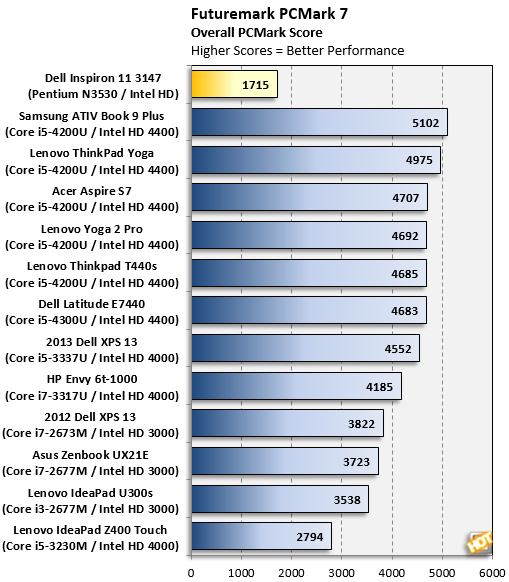Over the years, Futuremark has made a name for itself with comprehensive benchmarks that provide consistent results for comparing granular and big-picture performance. We put the Dell Inspiron 11 3147 through PCMark 7, which has been around for a while, and PCMark 8, which is the latest benchmark in the series. With PCMark 7, we’ve provided overall scores, while the PCMark 8 tests are broken out into three key modules.
 |
Futuremark PCMark 7
|
Simulated Application Performance
|
|

PCMark 7
|
PCMark 7 runs through the types of tasks your ultrabook is likely to
encounter during ordinary home and office use. It tests the system’s
graphics capabilities as part of the process, but you should think of
PCMark 7 as an indicator of system’s general usage performance. We’ll
get to the gaming-oriented benchmarks on the next page.
|
 |
|
Futuremark PCMark 8 |
|
Simulated Application Performance |
|

PCMark 8
|
PCMark 8 has several separate benchmarks. The Home test measures a system's ability to handle basic tasks: video chatting, web browsing, photo editing, and similar day-to-day activities. The test is designed to be run on just about any Windows 7 or 8 computer. The Creative test offers some of the same types of tasks, but puts more stress on the system and is meant for mid-range and higher-end systems. The Work test simulates the workflow of a typical office user. And the Storage test - you guessed it - benchmark's your system’s data storage performance.
|
Understandably, the Dell Inspiron 11 3000 isn’t going to compete with larger laptops. They have the room (both physically and in terms of price) to feature better hardware. The convertible’s scores are bound to be modest in all of our tests. Specifically, in PCMark 7, the Inspiron 11 3000's 5400 RPM hard drive likely is what held it back the most, with the
ultrabooks in our reference database sporting full SSDs for storage.












